
- Source: HYPERALLERGIC
- Author: MAYA PONTONE
- Date: JULY 31, 2023
- Format: DIGITAL
In Governors Island, Seven Video Artists Imagine Radical Futures
The group exhibition AntiVenom honors the potential of art and activism to transform harmful realities.

Installation view of AntiVenom (photo by Martin Seck, courtesy LMCC)
How do we transcend systematic harm? When confronted with manifold structures of violence, how do we establish our humanity?
AntiVenom, a group video exhibition at the Lower Manhattan Cultural Council (LMCC) Arts Center at Governors Island, offers audiences seven answers to these questions from seven LGBTQ+ and BIPOC artists. This immersive show celebrates the advancements made by marginalized creatives over the last several decades and their vital role in shaping our world, as it honors artists’ and activists’ ability to transform harmful realities through radical re-envisioning of our futures.
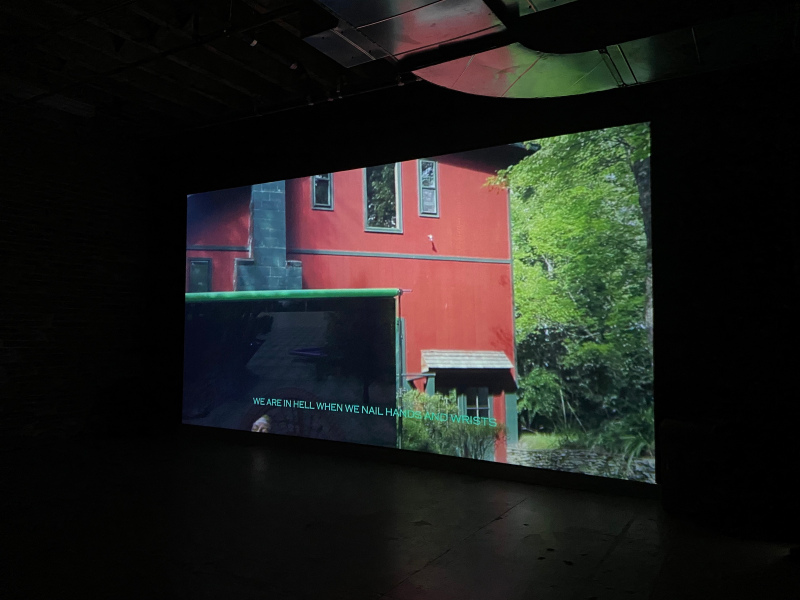
Installation view of Jacolby Satterwhite’s “We Are In Hell When We Hurt Each Other” (2020) (photo Maya Pontone/Hyperallergic)
On view from May 6 to October 1, the exhibition was developed in partnership with Allies in Arts (AIA), a nonprofit organization led by trans and queer folks that focuses on supporting marginalized women, BIPOC, and LGBTQ+ artists through exhibitions, grants, and other projects and initiatives. Curated by visual artist Sophia Wallace and AIA Director Drew Denny, AntiVenom presents work by Le’Andra LeSeur, Corinne Spencer, Amelia Winger-Bearskin, Andrew Thomas Huang, Joaquin Trujillo, Anna Parisi, and Jacolby Satterwhite: single-, double-, and triple-channel videos alongside two light sculptures.
Throughout AntiVenom, viewers in the darkened space are forced to reposition themselves as visuals are projected on different walls, resulting in vulnerability and slight confusion.

Installation view of Corinne Spencer’s “Hunger” (2019) (photo Maya Pontone/Hyperallergic)
Wallace compares the exhibition to “medicine,” explaining to Hyperallergic in an interview how the show was curated “in the very specific conditions of COVID.” She said after she personally went through a “harrowing birth experience,” she was interested in the ways in which each artist grappled with endangerment to envision alternative futures.
“More than two years into the pandemic at this point, it was a time that felt heavy with foreboding,” she said in a statement. “There was this constant tension between the ache of loneliness and fear that social proximity to others could be life-threatening.”
In “The Kiss of the Rabbit God” (2019), Huang weaves together themes of queerness, spirituality, and folklore. The 14-minute short film is a revelatory story of an exhausted Chinese-American service worker who is seduced by a red-haired god from the Qing Dynasty. LeSeur’s three-channel video “Superwoman” (2018) chronicles a self-baptism to the melody of Donny Hathaway’s cover of Stevie Wonder’s “Superwoman” (1972). The video honors Black queer femininity and the importance of self-love in times of internal struggle and transition. The artist’s work continues in a curtained-off alcove illuminated in cobalt by a multimedia installation. In a single-channel video titled “In Reverence (An Honoring)” (2018) on the middle wall, open palms bathed in golden sunlight reach upward into a clear blue sky. On the side walls, neon signs read, “Death by way of a beat … birth by way of a rhythm” and “Freedom like a breath … all blue” (both works 2023), conjuring themes of death, visibility, and transcendence.
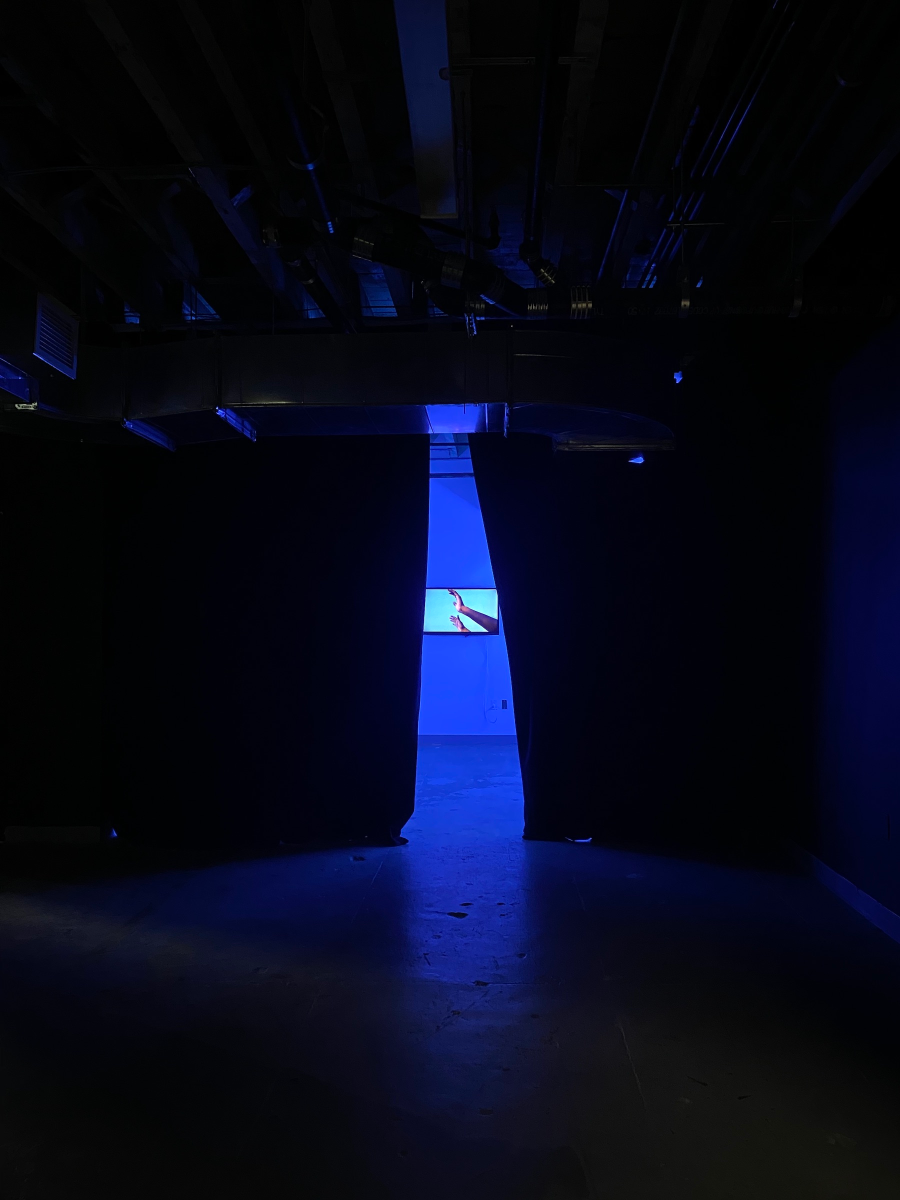
Installation view of Le’Andra LeSeur’s “In Reverence (An Honoring)” (2018) (photo Maya Pontone/Hyperallergic)

Installation view of Le’Andra LeSeur’s “Death by way of a boat…birth by way of a rhythm” (2023), neon, 60 inches x 6 inches (photo by Martin Seck, courtesy LMCC)
A three-dimensional animated music video by Satterwhite warns viewers of the cyclical, interconnected nature of violence. Over the course of 24 minutes, audiences watch mesmerizing, rainbow-colored dancers twist and bend their bodies in various otherworldly settings to song lyrics that repeat, “We are in hell when we hurt each other.” Spencer’s multisensory performance videos similarly evoke feelings of trauma and healing.
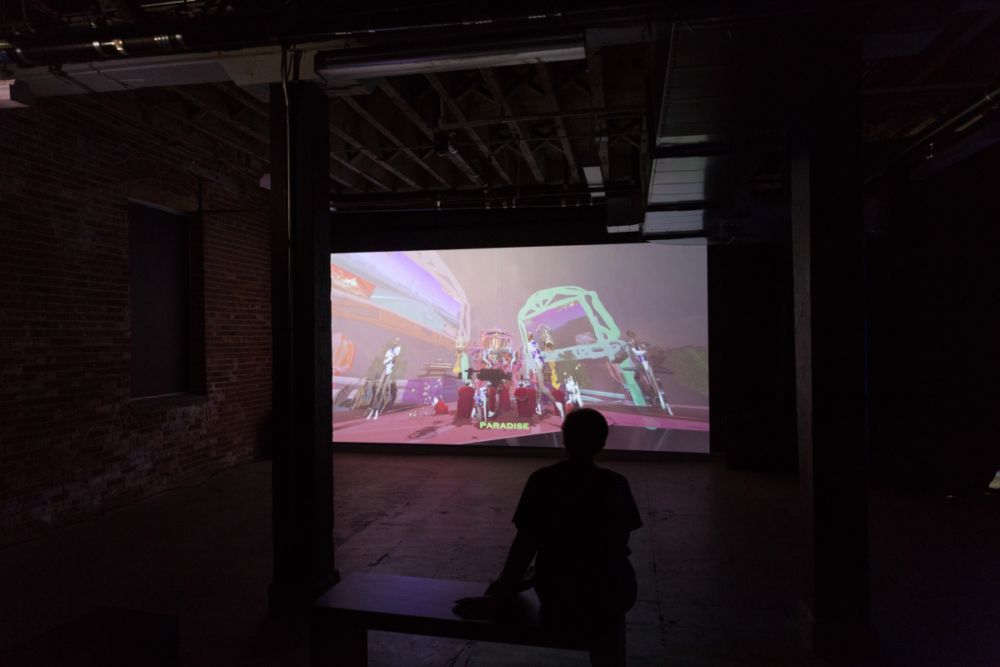
Installation view of Jacolby Satterwhite’s “We Are In Hell When We Hurt Each Other” (2020), single-channel 3D animation (© Gregory Gentert; photo by and courtesy Gregory Gentert
“Hunger” (2019) by Spencer presents visuals of Black femme individuals caring for one another and submerging their bodies in swirling, milky baths. The figures have a divine, mythological quality to them, dressed in white and holding symbolic objects such as metal pitchers and dripping rags in the wordless three-channel projection.
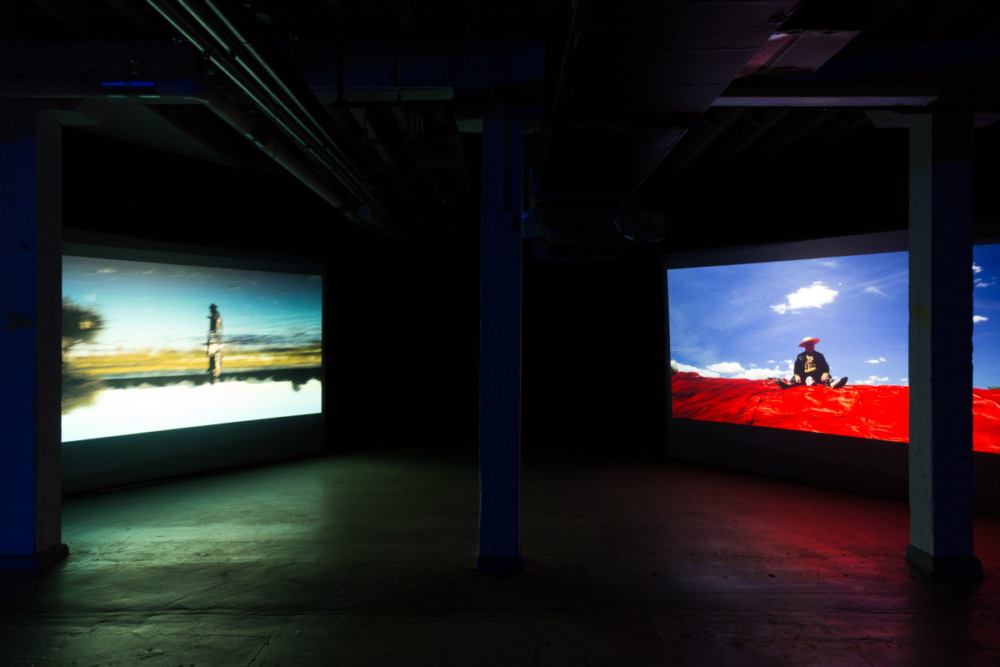
Installation view of Trujillo’s “El Viejo” (2016–2022) Single-channel, double-channel video (© Gregory Gentert; photo by and courtesy Gregory Gentert)
Winger-Bearskin’s combination of artificial intelligence, glitchy visuals, and poetic text conjures imagined worlds atop earthly landscapes in another set of videos, while Trujillo, who grew up in the rural outskirts of Zacatecas, Mexico, reclaims his previously hidden queer identity in “El Viejo”; the work follows a dancing old man, draped in red velvet, bells, and ribbons, through a dry ranch landscape.
“Working from their respective lineages, each of the artists in AntiVenom faces conditions of harm in spectacular ways. For anyone who is living in a state of paralysis and fear, these artworks break a spell of disconnection, perhaps from ourselves and our futures,” Wallace said in an email to Hyperallergic.
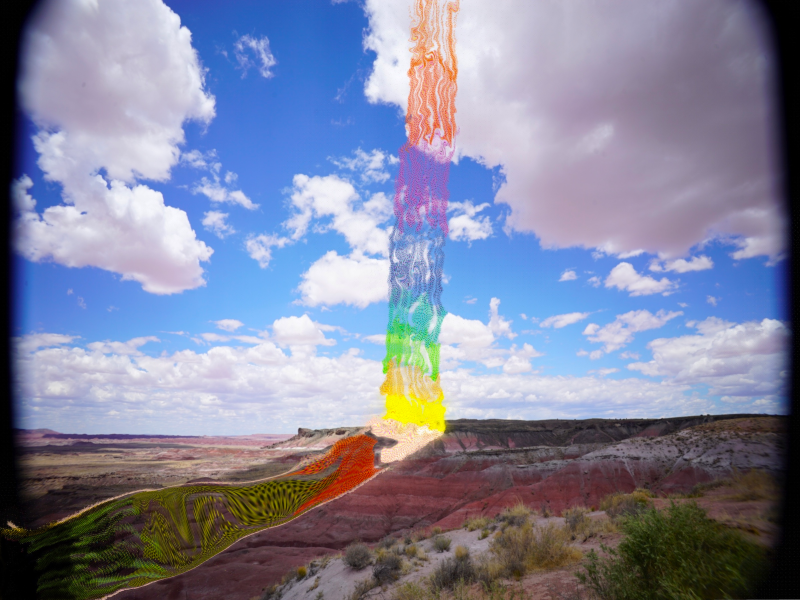
“Rain bow” (2023) digital image interpolation, landscape photographs, video (photo by and courtesy Amelia Winger-Bearskin)
AntiVenom is presented in conjunction with several live events at the Governors Island Art Center. On September 16, the center will host conversations with Trujillo and LeSeur, alongside a live performance and a DJ set. Audiences can expect an accompanying podcast episode developed with Pioneer Works Broadcast to be released in early September.

